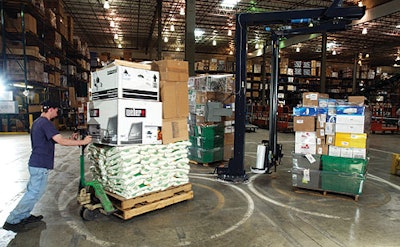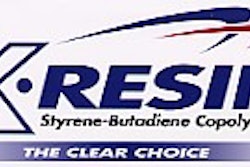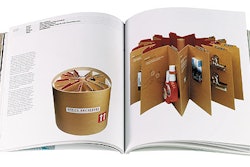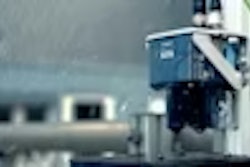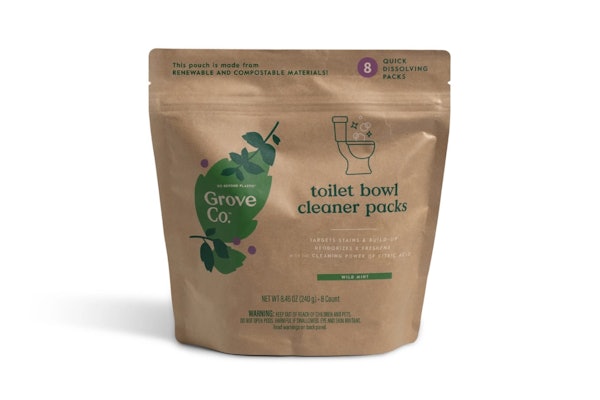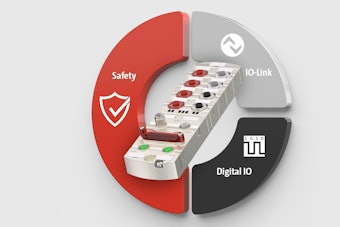Personnel at True Value’s Regional Distribution Center in Springfield, OR, decided it was time to improve the facility’s load-unitizing method. In early 2001 the center upgraded from manual stretch wrapping of pallet loads to semi-automatic.
Operations manager Roger Hansen sums the true value of the pair of semi-automatic stretch wrappers this way: “Install stretch-wrap machines, productivity rises about 20%, and back injuries are reduced. What more can you ask for? And the stores are happy because the loads are nice and tight, and merchandise isn’t spilling all over the truck.”
The wrappers operate over two shifts, unitizing loads destined for 520 company stores throughout five western states. The products palletized and wrapped include lawnmowers, paint, sinks, fertilizer... “whatever is found in a hardware store,” adds Hansen. Most products are boxed or crated in mesh or plastic.
The M-67 IS (integral stand) gantry-style, semi-automatic wrappers are made by Orion Packaging Systems (Collierville, TN). The wrappers use film carriages that revolve around the stationary load, which rests on the floor. That means that the load weight limit is virtually unlimited. Supplied through LBR Marketing (Battle Ground, WA), the wrappers are installed about 150’ apart. They are about 50’ from the nearest of the DC’s 50 dock doors to allow for forklift travel.
Swivel action
One of the units’ main features is a swiveling mast, which Hansen especially likes. In fact, it’s the reason for the DC’s increase in throughput—the swivel action allows the mast and carriage arm to turn 360° to access up to three pallet positions placed around it. Two loads can be moved into and out of position via pallet jacks or forklift trucks while a third one is wrapped.
Without the pivoting mast, only one load could be wrapped or moved at a time. Sometimes loads are moved in and out of one wrapping position, but for heavy demand periods all three positions are used.
To move the mast to a different load position, the operator hits a foot pedal that releases the pin lock in the base of the mast. The operator can swivel the wrapping mast and arm-mounted film carriage into another position, and the pin locks it. The ring assembly is mounted atop ball bearings, so it takes little effort to swivel the mast.
To wrap a load, the operator attaches the film end to the load.
Operators activate the wrapper by pushing on a bar located near shoulder height at the control panel facing away from wrapping. That activates the programmable logic controller-operated wrapping sequence. The film carriage circles the load at preset speeds to 14 rpm. Photoeyes enable the unit to accept loads of random heights.
Rolls of 20’’-wide 70-ga, 6ꯠ’-long PE film from LBR Marketing manufactured by Atlantis Plastic Films (Atlanta, GA) provide a 250% film prestretch. It replaces 18’’-wide, 1귔’-long rolls used for manual wrapping. Hansen reports that manual wrapping had been done for about six years and involved 25 operators, two more than now. The operators pick product, palletize the loads, haul them to and from wrapping, and run the wrapper. He adds that wrapping time has been halved to about three minutes.
When the load is completed, the operator tears the film, and the pallet is ready for loading onto a True Value truck.
Fatigue factor retired
Hansen is highly appreciative of the fact that the “fatigue factor” has been largely eliminated. “The [operators] have been wrapping by hand for many years,” he says. “They do a lot of stacking and moving and pushing and loading. We found out that while working full shifts daily in shipping, the fatigue factor takes effect in terms of the quality of the wrapping and the amount of damaged product. Now, they’re not bent over all day long, and their backs aren’t aching.
“We haven’t had a lost-time accident in shipping for a year or so because of these machines. When workers get tired, then accidents occur, and they can get hurt. We think that these machines have really helped us. It keeps the operators stronger and not as tired. Plus, they are producing more wrapped loads.”
The facility measures efficiency in terms of pounds of product per operator-hour. Those figures for manual wrapping were around 2괌 lb/operator-hour. “Now, that’s up to 3꺜,” says Hansen, pointing to the wrappers as the difference. He figures the improvement produced a one-year payback.
True Value is already planning to add a third Orion stretch wrapper at the DC.
